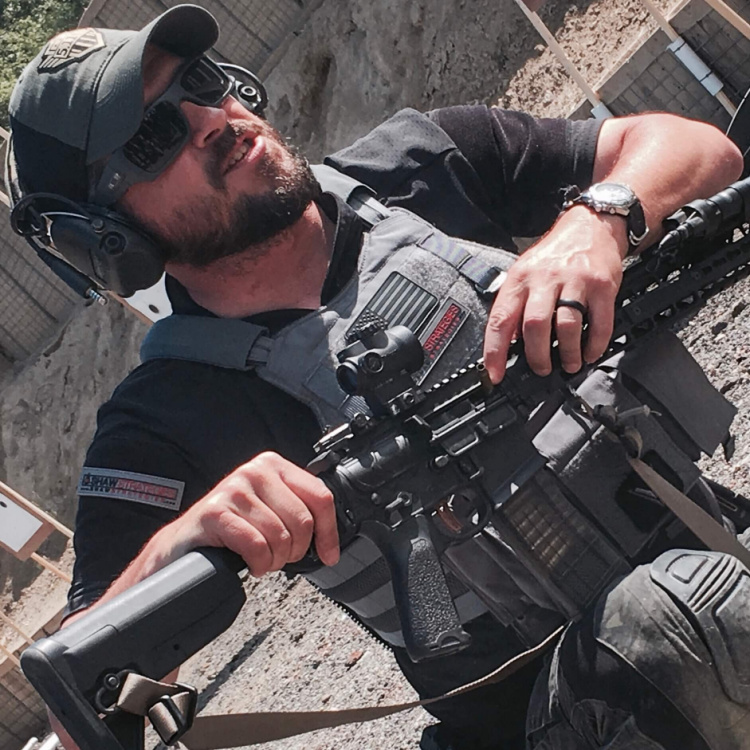Daniel is solo for this episode as he talks about the Avtomat Kalashnikova and its variants. Beginning with the story of how Mikhail Kalashnikov came to design the AK-47, Daniel covers the general characteristics, a couple of it’s faults, and then he runs through the variants from the original 47 to the 100 series.
He also covers practical issues with the AK-47 like zeroing it and accuracy concerns. At the end, there’s a bit of Q&A with questions from GunFighter Cast Listeners.
Listen up and learn more about the AK-47!

History of the AK-47
Host: Daniel Shaw
Introduction/Timeline: Stephanie Kimmell
3:51 The genesis of the AK-47 happened somewhere around 1941, during World War II. It was actually a tank sergeant that developed it, not a gun manufacturer or anything.
Mikhail Kalashnikov was injured on the front lines, over on the eastern front when his tank was hit by some artillery rounds. He went on some convalescence and took a little break to recover from his injuries. While he was there, he entered a small arms competition that was being held by the Soviets. They were basically wanting to improve their battle rifle.
Kalashnikov jumped into the competition because he had previously made a few different modifications that got him some awards for the T34 tank. He was able to get into this competition and he came up with a submachine gun design that looked like it was going to be pretty decent. Ultimately, that design ended up being a little too complicated and the production time was going to take way, way too long.
The Soviets didn’t buy off on that first submachine gun, which kind of looked like a Thompson. It ended up being beaten by the PPS 43 which is a lot easier and faster to make. It was pretty easy for the conscripts to pick up and use the PPS 43 without very much education or training on them.
If you go forward a few years, by around 1944 the Soviets had captured a lot of german weapons. Kalashnikov looked at those, trying to figure out how they work. As it turned out, the Sturmgewehr 44, which has been known to be the father of all modern assault rifles, ended up being one of the major influences on the AK-47.
5:29 So, Kalashnikov started working on a few different designs. The first couple of attempts weren’t so great and they had to make a few changes to them. The first automatic Kalashnikov he came out with, after those changes were made, kind of went into the full production model. They actually took the design of the cartridge that the Strumgewehr 44 shot, which was a 7.92×33 Kurtz—just shortened. They had basically taken a 7.92×57 Mauser and shortened its cartridge length. That’s where the Soviets ended up coming up with the 7.62×39.
6:10 The AK-47 itself was actually not ready for production until 1949. Sometime around the mid-’50s, it was in use by pretty much all of the infantry for the former Soviet Union and many other communist nations.

At the time, the original had a milled receiver, and they pumped out so many of these, that this is the one you see all over the place. It was the base model that was basically used as a template from that point forward to make the many different variants that are out there.
6:41 For a while, Kalashnikov denied that he took the information, based, somewhat, on the Stermgewehr 44. Later on, he admitted that it was a major influence.
General Characteristics of the AK-47
6:53 Obviously, Russia is the country of origin. It shoots 7.62×39 cartridge and normally uses a 30-round box magazine. You can get some different magazines for the AK depending on how many rounds you want and how long you want that magazine to be.
Its gas operated using a long-stroke piston with a maximum effective range of about 300 meters. It shoots about 600 rounds a minute. The overall length is 34.6 inches and the length of the barrel is 16.3 inches. Dry, it weighs about 8.3 to 8.5 pounds.
A few faults with the AK-47
7:30 The bolt doesn’t lock back to the rear like our favorite AR-15 does when the magazine goes empty. Daniel considers it a fault in modern weapons if the bolt doesn’t lock back.
The AK-47 has a very, very short sight radius, so any minor imperfection in the sights is greatly amplified. Having a little bit longer of a sight radius would help it out quite a bit on accuracy.
The gas tube at the front that feeds the gas to initiate the long-stroke piston system is exposed. It’s a very thin piece of metal and could be banged up and beaten too easilyl.
Strangely enough, the sights on the AK-47 are marked up to 800 meters but the weapon is not capable of 800-meter accuracy. On the AKM, it actually goes up to 1000 meters. Generally, this is believed to be a morale killer for enemy combatants. If they pick it up on the battlefield and look at it, they’ll think they’re not safe a click away.
AK-47 Variants
8:39 One variant that you may see is the AKS that came around sometime in the 50s. The S stands for ‘Stock’. They basically added a double-strutt metal stock to the AK-47, which is an under-folding stock.

If you press a button on the side, it’ll fold under and back. It was used mostly with Russian Airborn and some mechanized troops. One problem with this design was not being able to really manipulate the safety and fire-selector lever on the right hand side when that stock was in its forward position.
9:16 In 1959, the AK was modernized and became the AKM, which ended up replacing the original AK-47s. Basically, it was a regular AK with some modifications. The M stands for ‘Modernization’. You may see some of those with a spoon-type compensator, with the spoon down to the right. That way, if a right handed shooter’ fired it, the jump angle was decreased because the gas was sent out in a different direction. The theory was to keep it down a little bit.

The AKM was the model with the sights changed to 1000 meters to kill the morale a little bit more. Also, they went with a stamped metal receiver and got rid of the milled receiver. It made the weapon a little bit lighter and easier to carry around for long periods of time. The stamped receiver also allowed for quick mass production.
10:06 Another variant is the AKMS, which is basically an AKM. It has the stamped, folding, double-strut stock.

10:14 Moving ahead a few more years, full production began on the AK-74 around 1976. The whole premise behind the 74 was the Russians were getting some intelligence on the ballistics and efficiency of the M16 that we were using in the 5.56. They saw that the lighter round could be cheaper and faster to produce, easier to carry, less weight, and the logistics of moving those to the battlefield were a little bit easier. They observed the good ballistic results when our rounds hit bad guys so they wanted to develop something that could counter it that had a small-bore, high-velocity cartridge for themselves.

Basically, it is an AK-47, but they changed a few features on it. It actually has a true compensator that greatly reduces muzzle climb and recoil. Some say it’s one of the best out there. The AK-74 shoots the 5.45×39 round which is generally lighter and a little bit smaller. They usually have some plastic parts and magazines to make it even lighter than wood parts that were previously seen on the AK-47. It’s much more accurate than the AK-47. You’re easily hitting targets out to 500 yards with the AK-74. Now, it’s standard issue for Russian troops.
The AK-74 itself has a few different variants, like the AK-74U, which is commonly known to Russians as “Little Bitch”. Another name for it is Krinkov, meaning “short” because it is a much shorter carbine version.
Newer AK Versions
11:50 The AK-100 series can be 7.62×39, 5.45×39, or 5.56×45. It’s not as common as the AK-47 and other variants, but it’s out there.

Here’s the rundown on the AK-100 series.
•The AK-101 shoots 5.56 NATO.
•The AK-102 is a short-barrel 5.56 NATO.
•The AK-103 is a 7.62×39.
•The AK-104 is 7.62×39 with a short barrel.
•The AK-105 is also a short-barrel with 5.45×39.
•The AK-107 is a dual-piston system 5.45×39.
•The AK-108 is also a dual-piston system shooting 5.56 NATO.
Zeroing Your AK
12:34 If you’ve got an AK and you want to zero it, you want to do it at 25 meters. Set your rear sight to 100. Make sure you’ve got the Kalashnikov Sight Adjustment Tool (KSAT). You can pick those up at most gun shows or order them online.
Just remember that each full rotation of the front sight post is 5 cm at 25 meters. Each millimeter of movement of the windage knob is 6.5 cm at 25 meters. Moving the front sight post clockwise will move the post down, which causes the strike of the round to move up, and vice-versa if you need to go the other way. Pushing the windage drum left moves the strike of the round to the right, and the opposite if you want to go the other way.
13:16 Daniel has played with AK’s quite a bit throughout the years, but never owned one. He believes you don’t truly know a gun until you own one. So he’s looking at buying one. He’s going to talk about that in a few minutes.
AK Accuracy
13:26 Daniel recently went to a Foreign Weapons Instructor course in Virginia. At the class, he learned about numerous foreign weapons that have been used throughout history and still are used currently in various theaters. He thought he knew the AK a little bit before he got there but he learned a heck of a lot more than he already knew and got quite a bit of trigger time behind it.
Some people call it M4 Appreciation, because the more you shoot these guns, the more you learn to appreciate the M4. Daniel agrees with that because he truly appreciates his M4. That being said, he does not mind an AK. He would not hesitate to do a battlefield pickup at all. If he needed to go to an AK, he would not have any qualms about it. If you get a good one that’s going to run reasonably accurate—it’s not quite as accurate as the M4—but still, it’s got good accuracy for most of the ranges that we’re fighting at right now.
14:19 Speaking of accuracy, people say the AK is not accurate at all. Daniel says they actually shot the Marine Corps Qualification at the course. The qualification is done at the 200-yard line, 300-yard line, and 500-yard line. He ended up going to the 100-yard line and he had an old gun. It was crazy old; had been shot a thousand gazillion bazillion times and was all beat up and worn out. It ran well, and he didn’t have any troubles.
They started out at the 100-yard line, just confirming the battlesight zero, shooting at a target that was slightly smaller than man-sized. Daniel hit 10/10 in vital kill areas with no trouble at all.
Back at the 200-yard line, he ended up hitting 22/25, and some of that could have been shooter error. It’s reasonable to assume that if he went back and practiced a little bit more with the AK he would easily be hitting 25/25 at the 200-yard line with no issue. The weapon is capable.
At the 300-yard line, Daniel hit 14/15. Again, it could have been something he did with that one shot. He doesn’t blame the gun and thinks he could hit all 15 if he went back again and did it a couple of times.
Finally, at the 500-yard line, Daniel says, “That’s when you see the accuracy really start to degrade.”
He usually gets all his shots in with his M4 or M16 at the 500-yard line, but with the AK, he shot 6/10 on that smaller-than-man-sized target. He doesn’t think that’s too shabby. The weapon is capable of hitting man-sized targets at 500-yards, and this was with stock iron sights—the ones that came on it—no modifications whatsoever.
What does that mean to you?
15:56 If you hear that the AK’s just not accurate, but you’ve analyzed your life, and you need this weapon or a semi-auto rifle, (an AR or an AK), and you think you’re never going to need to take a shot over 300-yards, the AK is going to serve you just as well. Daniel thinks the AK isn’t going to have any issue trying to hit man-sized targets, small game, or whatever it is you’re shooting. At 300 yards, with a little practice, it’s very, very capable.
However, if you need accuracy at 400 or 500 yards, then you might want to start leaning toward the AR again. Still, if your needs are at 300 yards and under, save a little cash. Go ahead and get an AK.
Of course there are many other factors that come into it but if accuracy if your main thing, there you go.
AK-47 Q&A
These are some questions that came through on Facebook when listeners heard we were doing this show.
17:08 In your respective career in law enforcement and the Marines, did either of you do anything with the AK? How do you feel it performed compared to the AR and some non-AR platforms: FAL, M14, FN SCAR, Mark 16?
Daniel says if he’s getting ready to go to a gunfight and he has an M4 and an AK sitting there, he’s grabbing the M4. That’s his go-to gun that he’s carried and used for years. He knows it inside and out. There is no hesitation with problem-solving any issue that may come up with the gun—he’s picking the M4.
His next choice, (other than FAL, M14, SCAR, Mark 16), probably going to go with the AK. It also depends on a few other things, like what range is he going to be shooting at.
18:24 What would make a good economical reflex sight for an AK, considering it’s an AK and it probably isn’t worth putting top-dollar sights on it?
It depends. Are you going with an AK because its economical? Daniel says that’s what sold him on the AK. The one he plans to buy isn’t the most economical AK but the 7.62×39 round is…very, very affordable. He plans to get the AK and get an AK-74 his wife an AK-74 later on. That way, they will actually be able to afford going out to the range and having fun. He can’t afford to train with .308 or 5.56. There’s quite a price difference, and some of this ammo is pretty good stuff for very cheap.
If you’re going for economical, there are a few out there Daniel’s been looking at recently. Vortex, Bushnell stuff that’s kinda cheap that looks pretty good.
Burris—Daniel hasn’t had a lot of experience with them so wants to know, if any listeners use them: how well does it hold a zero? Can they get beat up a little bit and still be ok? If the answer to those questions is yes, then those will probably be good optics to go with.
What Daniel’s planning to put on his AK-47 is a Trijicon Reflex. He’s trying to find an older used one because if he has to buy one of the new ones, it’ll be about $400.00.
He doesn’t really have a specific optic to tell you to go buy. He hasn’t played with many of the cheap ones.
20:10 Where can you go to get a good mid-level AK?
Daniel’s looked at quite a few companies recently, and he’s decided that he’s going to go with an I.O Incorporated AK-47 called the HellHound Tactical.

It’s got a rail system in the front, so he can put a light and foregrip on it, and it’s got a flat top so he can put a reflex sight on it.
22:26 If you have anything to add about the AK, let us know. Your feedback is welcome, wanted, needed, and encouraged.
Podcast: Play in new window | Download


